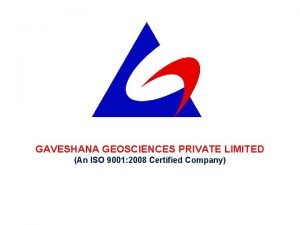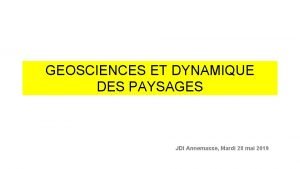Faculty of Geosciences Environmental Sciences Adapting Chemical Risk

- Slides: 1

Faculty of Geosciences Environmental Sciences Adapting Chemical Risk Assessment for Water Systems in relation to Unconventional Hydrocarbons Ann-Hélène Faber 1, 2, 3, M. P. J. A. Annevelink 2, P. de Voogt 2, 3, P. P. Schot 1, A. P. van Wezel 1, 2 Background 1 Typical Chemical Risk Assessment (CRA) Known compound CRA for unconventional hydrocarbons A large variety of compounds Chemical analysis of unconventional hydrocarbon related water Broad screening with HPLC … Chemical additives (Fracfocus) Exposure Hazards Subsurface contaminants (literature) Risk Characterisation (RC) … Fracturing Fluid Risk Characterisation more complex Focus on EXPOSURE (hazard remains unchanged) Figure 1: Typical chemical risk assessment vs. risk assessment for unconventional hydrocarbons Flowback/production water • Water phase needs to be isolated (centrifugation) • No need to isolate water phase • Direct injection possible • Need for concentration (SPE) Figure 2: Differences in sample preparation between different water types due to differences in composition/concentrations Where and how to adapt chemical risk assessment for unconventional hydrocarbon activities? … using a SUSPECT LIST including … Chemical additives Subsurface contaminants and • Fracfocus database • NAM database Research Questions • Literature: Orem et al. 2014, Hayes 2009, Olsson et al. 2013, etc. ) How to assess the different water types and the large number of chemicals? 1 of 189 236 How applicable are available models for environmental fate modelling? 2 Groundwater (shallow) regulated under REACH not regulated under REACH Only 45% of compounds included in the suspect list are regulated under REACH Sjerps et al. 2016 Figure 3: Compounds from suspect list regulated under REACH How applicable are current water quality monitoring methods to unconventional drillings? 3 Ongoing research: Chemical and biological analysis of polar organic compounds analysed in hydraulic stimulated gas well related waters, at KWR. Kolkman et al. 2013 2 Conceptual Box Models (QWASI; SIMPLEBOX, etc. ) Mackay et al. 2014; Hollander et al. 2016 Chemical fate information – EPI Suite: experimental vs. estimated values • The reactivity of persistent organic pollutants is overestimated (Gouin et al. 2004) Discussion & Conclusion 1 • Currently only 45% of suspect list compounds are regulated under REACH. Toxicological information – TOXNET • Information not available for all compounds Current conceptual box models are based on … Surface/shallow exposure routes Models for unconventional hydrocarbon activities need to consider … More complex exposure routes Wastewater 2 • Fracturing fluid There is a need (1) for more research into chemical fate under downhole conditions, and (2) for relevant exposure routes to be integrated into the environmental fate models. Aquifer 3 • Current water quality monitoring is insufficient for risk assessment of unconventional drillings. Deep underground monitoring may be developed (1) via technology to increase accessability, and (2) via legislation. Figure 4: Conceptual box model exposures (socopse 2016 – example QWASI model) Pressure : 101325 Pa Temperature : 27°C References • • • European Commission (2015). http: //ec. europa. eu/environment/water-framework/groundwater /resource. htm Gouin, T. , Cousins, I. , & Mackay, D. (2004). Chemosphere, 56(6), 531 -535. Hayes, T. 2009. Marcellus Shale Coalition: http: //energyindepth. org/wp-content/uploads /marcellus/2012/11/MSCommission-Report. pdf Hollander, A. , Schoorl, M. , & van de Meent, D. (2016). Chemosphere, 148, 99 -107. Kahrilas, G. A. , Blotevogel, J. , Stewart, P. S. , & Borch, T. (2014). Environmental science & technology, 49(1), 16 -32. Kolkman, A. , Schriks, M. , Brand, W. , Bäuerlein, P. S. , van der Kooi, M. M. , van Doorn, R. H. , . . . & Heringa, M. B. (2013). Environmental toxicology and pharmacology, 36(3), 1291 -1303. Mackay, D. , Hughes, L. , Powell, D. E. , & Kim, J. (2014). Chemosphere, 111, 359 -365. Olsson, O. , Weichgrebe, D. , & Rosenwinkel, K. H. (2013). Environmental earth sciences, 70(8), 3895 -3906. Orem, W. , Tatu, C. , Varonka, M. , Lerch, H. , Bates, A. , Engle, M. , . . . & Mc. Intosh, J. (2014). International Journal of Coal Geology, 126, 20 -31. Sjerps, R. M. , Vughs, D. , van Leerdam, J. A. , ter Laak, T. L. , & van Wezel, A. P. (2016). Water research, 93, 254 -264. Socopse: Source Control of Priority Substances in Europe (2016). http: //www. socopse. se/decisionsupportsystem/tools/quickguidetoenvironmentalfatemodels. 4. 3 d 9 ff 17 111 f 6 fef 70 e 9800068582. html U. S. EPA. U. S. Environmental Protection Agency, Washington, DC, EPA/600/R-15/047, 2015. & 1 Copernicus Institute - Utrecht University 2 KWR Watercycle Research Institute 3 IBED – University of Amsterdam Figure 5: Exposure routes for unconventional hydrocarbon activities U. S. EPA 2015 Surface conditions • Spills/Leaks Downhole conditions Pressure : ≈25 GPa Temperature : ≈ 100°C Increased T and P may affect chemical fate parameters Kahrilas et al. 2014 3 Water Quality monitoring Surface Shallow underground Deep underground Figure 6: Surface and underground water quality monitoring Shallow underground ≈ first 100 meters vs Hydraulic fracturing depth ≈ 4000 m Deep underground limited/no monitoring: • difficult to access • failures and their probabilities are not known European Commission 2015 Research topic: Chemical risk assessment of hydraulic fracturing for shale on water systems, in the Netherlands (2015 -2019).

